Parametric Studies of a Mercury-Free DBD Lamp
Abstract
1. Introduction
2. Materials and Methods
2.1. Planilum Lamp
2.2. Experimental Studies
Standard Case
3. Results
3.1. Pulse Power Supply
3.2. Optimizations Studies: Efficacy vs. (Pressure, Frequency and Power)
- The luminance increases with the power as the excimer production. There is more UV photon produced by the discharge converted on a visible wavelength by the phosphors;
- An increase in the frequency shifts the luminance value toward high power. For the same applied voltage, it is possible to achieve higher luminance using higher power and higher frequency. Efficacy decreases with power and frequency;
- Efficacy is calculated from measured luminance and power. The increase of the current leads to an increase of the consumed power faster than the luminance so guiding a decrease of the efficacy.
3.3. Geometry Influence
- The surface reduction of the electrode decreases the optical transmission losses through the electrodes, allowing the same output for lower power.
4. Discussion
5. Conclusions
Author Contributions
Funding
Institutional Review Board Statement
Informed Consent Statement
Data Availability Statement
Acknowledgments
Conflicts of Interest
References
- Kadam, A.; Nair, G.B.; Dhoble, S. Insights into the extraction of mercury from fluorescent lamps: A review. J. Environ. Chem. Eng. 2019, 7, 4. [Google Scholar] [CrossRef]
- Hu, Y.; Cheng, H. Mercury risk from fluorescent lamps in China: Current status and future perspective. Environ. Int. 2012, 44, 141–150. [Google Scholar] [CrossRef]
- Zissis, G. Energy Consumption and Environmental and Economic Impact of Lighting: The Current Situation. In Handbook of Ad-vanced Lighting Technology; Karlicek, R., Sun, C.-C., Zissis, G., Ma, R., Eds.; Springer International Publishing: Berlin/Heidelberg, Germany, 2016; pp. 1–13. [Google Scholar]
- Li, G.; Fleetham, T.; Li, J. Efficient and Stable White Organic Light-Emitting Diodes Employing a Single Emitter. Adv. Mater. 2014, 26, 2931–2936. [Google Scholar] [CrossRef]
- Reineke, S.; Lindner, F.; Schwartz, G.; Seidler, N.; Walzer, K.; Lüssem, B.; Leo, K. White organic light-emitting diodes with fluorescent tube efficiency. Nat. Cell Biol. 2009, 459, 234–238. [Google Scholar] [CrossRef]
- Bender, V.C.; Marchesan, T.; Marcos Alonso, J. Solid-State Lighting: A concise Review of the State of the Art on LED and OLED Modeling. IEEE Ind. Electron. Mag. 2015, 9, 6–16. [Google Scholar] [CrossRef]
- Kamegaya, T.; Matsuzaki, H.; Yokozawa, M. Basic study on the gas-discharge panel for luminescent color display. IEEE Trans. Electron. Devices 1978, 9, 25. [Google Scholar] [CrossRef]
- Meunier, J.; Belenguer, P.; Bœuf, J.P. Numerical model of an ac plasma display panel in neon-xenon mixtures. J. Appl. Phys. 1995, 78, 731–745. [Google Scholar] [CrossRef]
- Beaudette, T.; Guillot, P.; Belenguer, P.; Callegari, T.; Auday, G. Experimental characterization of dielectric barrier discharges for mercury-free flat lamps. In Proceedings of the 18th Europhysics Conference on Atomic and Molecular Physics of Ionized Gases, ESCAMPIG XVIII, Lecce, Italy, 12–16 July 2006. [Google Scholar]
- Caillier, B.; Beaudette, T.; Guillot, P.; Belenguer, P.; Therese, L. Spatial Emission of a Dielectric Barrier Discharge Lamp Driven by Sinusoidal or Square Voltage Excitation. In Proceedings of the ESCAMPIG, Granada, Spain, 9–13 June 2008; Windholz, L., Ed.; Europhysics Conference Abstracts 32 E. [Google Scholar]
- Carman, R.J.; Mildren, R.P. Computer modelling of a short-pulse excited dielectric barrier discharge xenon excimer lamp (172 nm). J. Phys. D Appl. Phys. 2002, 36, 19–33. [Google Scholar] [CrossRef]
- Mildren, R.P.; Carman, R.J. Enhanced performance of a dielectric barrier discharge lamp using short-pulsed excitation. J. Phys. D Appl. Phys. 2000, 34, L1–L6. [Google Scholar] [CrossRef]
- Kogelschatz, U.; Eliasson, B.; Egli, W. From ozone generators to flat television screens: History and future potential of dielec-tric-barrier discharges. Pure Appl. Chem. 1999, 71, 1819–1828. [Google Scholar] [CrossRef]
- Lee, J.; Oh, B.J.; Jung, J.C.; Whang, K.-W. High luminous efficiency mercury-free flat light source for LCD BLU. In IMID 05 Digest; The Korean Information Display Society: Seoul, Korea, 2005; pp. 1161–1164. [Google Scholar]
- Urakabe, T.; Harada, S.; Saikatsu, T.; Karino, M. A Flat Fluorescent Lamp with Xe Dielectric Barrier Discharges. J. Light Vis. Environ. 1996, 20, 20–25. [Google Scholar] [CrossRef]
- Caillier, B.; Guillot, P.; Therese, L.; Beaudette, T.; Belenguer, P. Spatial emission behaviour of dielectric barrier discharge lamp driven by sinusoidal or pulsed voltage excitation. In Proceedings of the IEEE 35th International Conference on Plasma Science, ICOPS 2008, Karlsruhe, Germany, 15–19 June 2008; p. 1. [Google Scholar]
- Shiga, T.; Ikeda, Y.; Mikoshiba, S.; Shinada, S. Mercurey-free Xe flat discharge lamps for lighting. J. Light Vis. Environ. 2001, 25, 10–15. [Google Scholar] [CrossRef][Green Version]
- Shiga, T.; Mikoshiba, S.; Pitchford, L.C.; Boeuf, J.P. Investigation of efficacy in mercury-free flat discharge fluorescent lamp using a ze-ro-dimensional positive column model. In ICPIG 2003; Contributed Paper; Greifswald INP: Greifswald, Germany, 2003. [Google Scholar]
- Shiga, T.; Pitchford, L.C.; Boeuf, J.-P.; Mikoshiba, S. Study of efficacy in a mercury-free flat discharge fluorescent lamp using a ze-ro-dimensional positive column model. J. Phys. D Appl. Phys. 2003, 36, 512–521. [Google Scholar] [CrossRef]
- Ouyang, J.; Callegari, T.; Caillier, B.; Boeuf, J.-P. Large-gap AC coplanar plasma display cells: Macro-cell experiments and 3-D simulations. IEEE Trans. Plasma Sci. 2003, 31, 422–428. [Google Scholar] [CrossRef]
- Caillier, B. Diagnostics et Modélisation D’une Cellule D’écran à Plasma. Ph.D. Thesis, Université Paul Sabatier, Toulouse, France, 2004. [Google Scholar]
- Fiegler, M.; Ziemssen, K.; Homberg, B. A high resolution 5 mega pixel LCD display for medical applications with mercury-free flat panel lamp backlighting (PLANON). In SID 03 Digest; Society for Information Display: Baltimore, MD, USA, 2003. [Google Scholar]
- Lin, C.-Y.; Chao, R.-C.; Sung, Y.-C. LED Flat Lamp. 7677782. Available online: http://www.google.fr/patents?id=VafNAAAAEBAJ (accessed on 7 May 2012).
- Caillier, B.; Caiut, J.M.A.; Muja, C.; Demoucron, J.; Mauricot, R.; Dexpert-Ghys, J.; Guillot, P. Decontamination Efficiency of a DBD Lamp Containing an UV-C Emitting Phosphor. Photochem. Photobiol. 2015, 91, 526–532. [Google Scholar] [CrossRef]
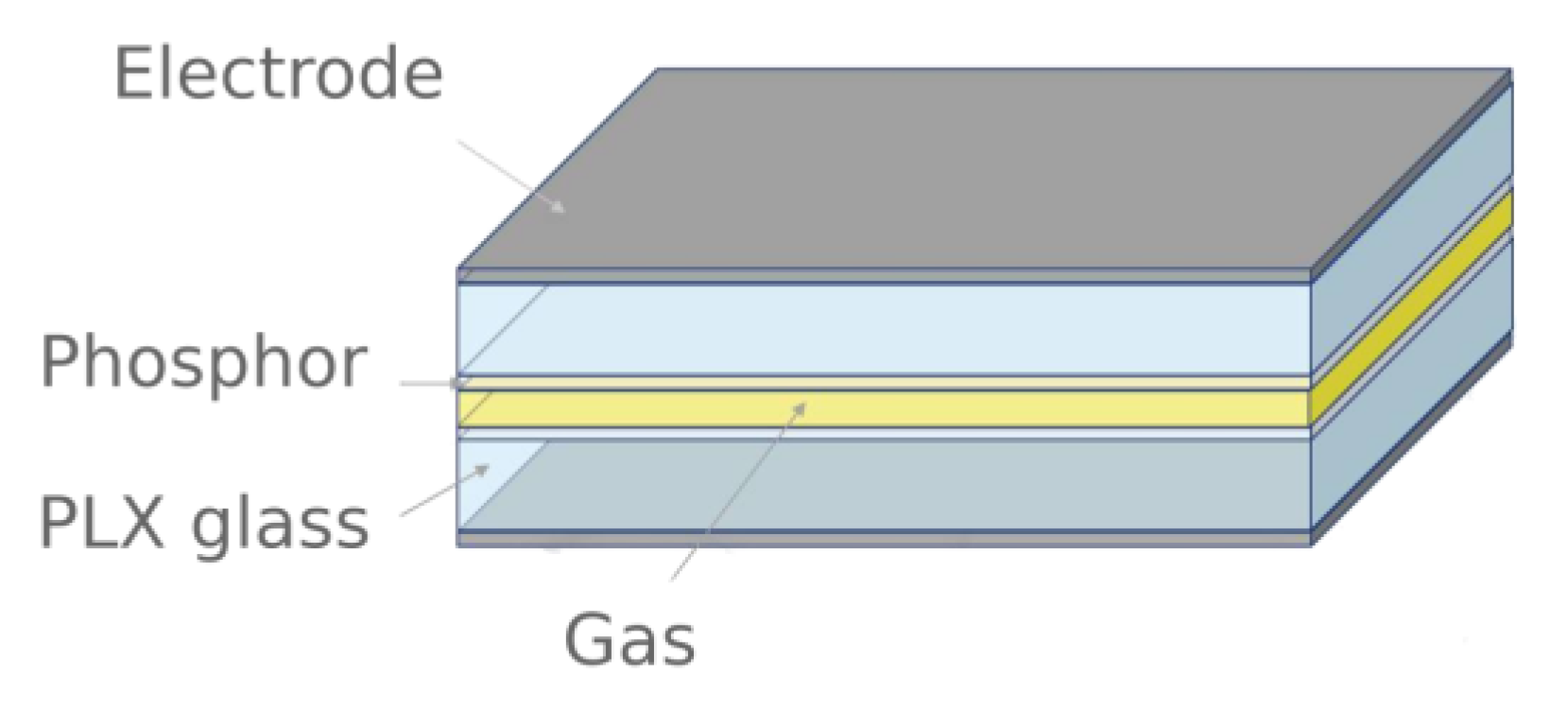
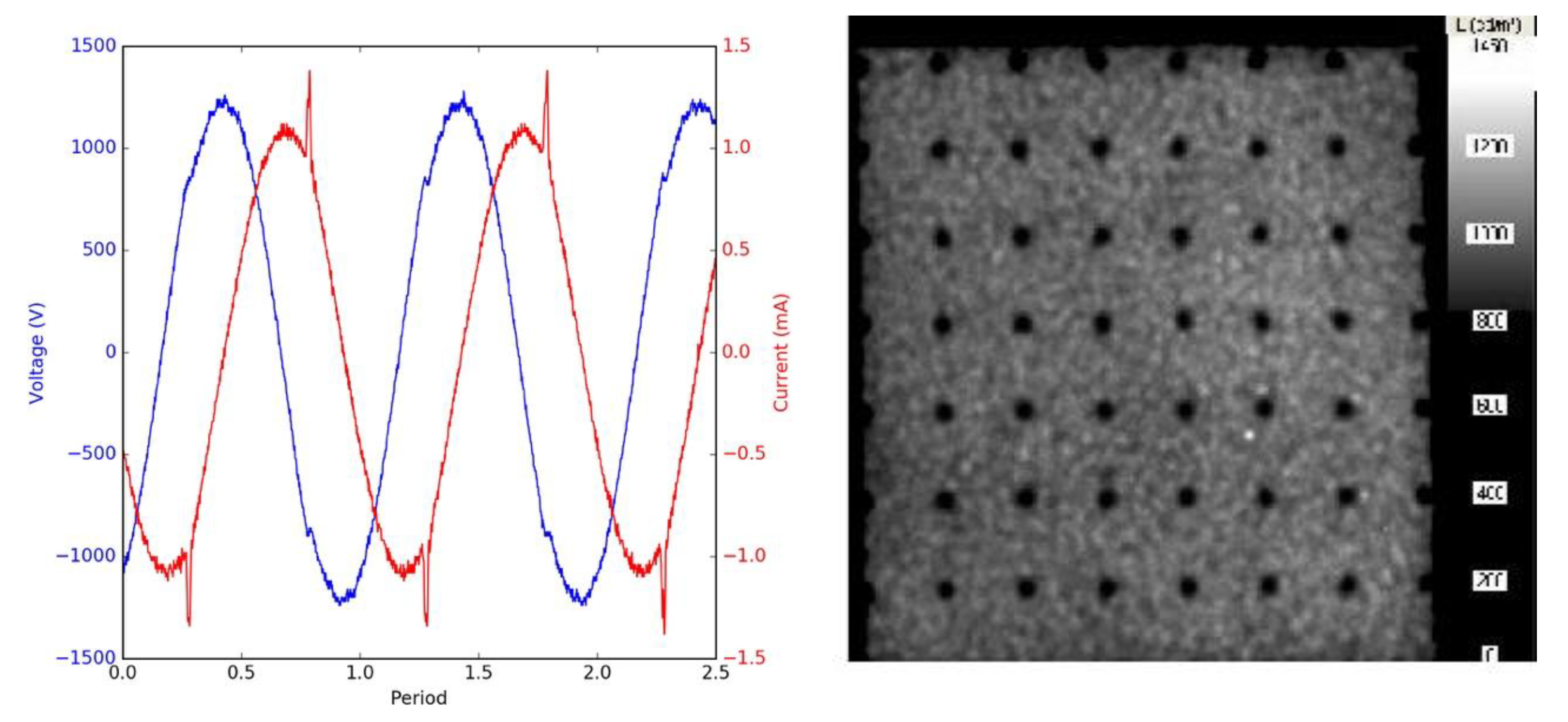
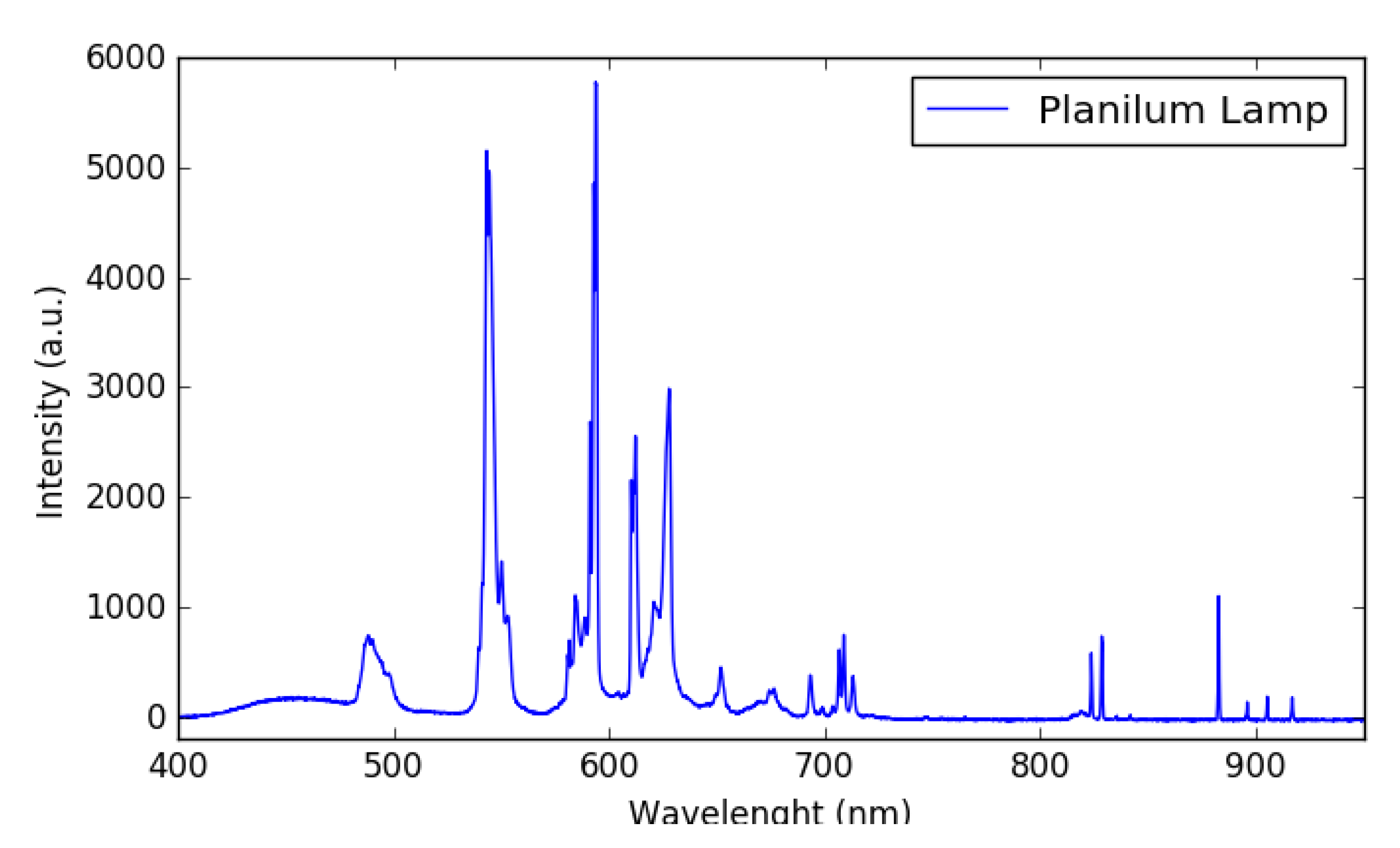
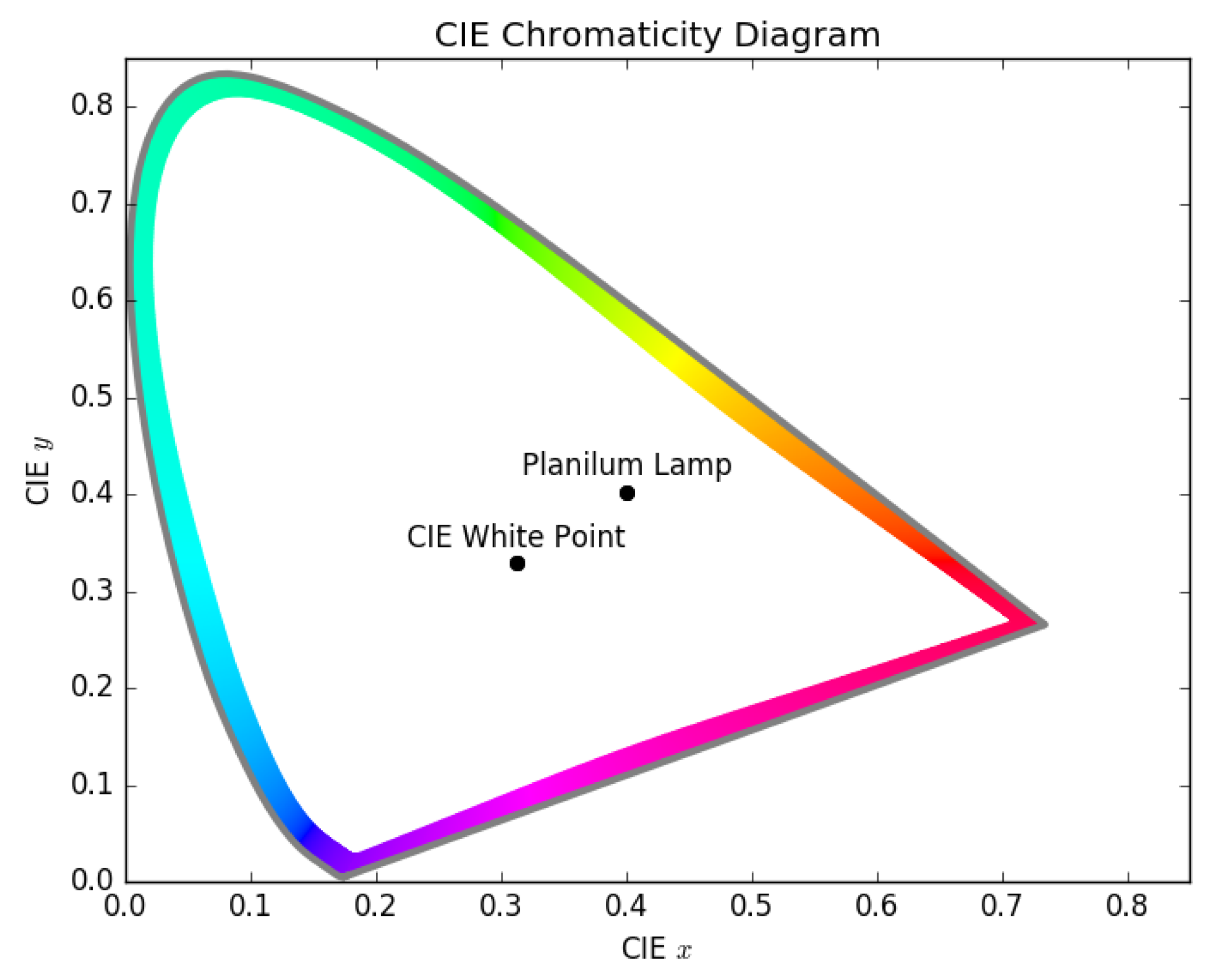
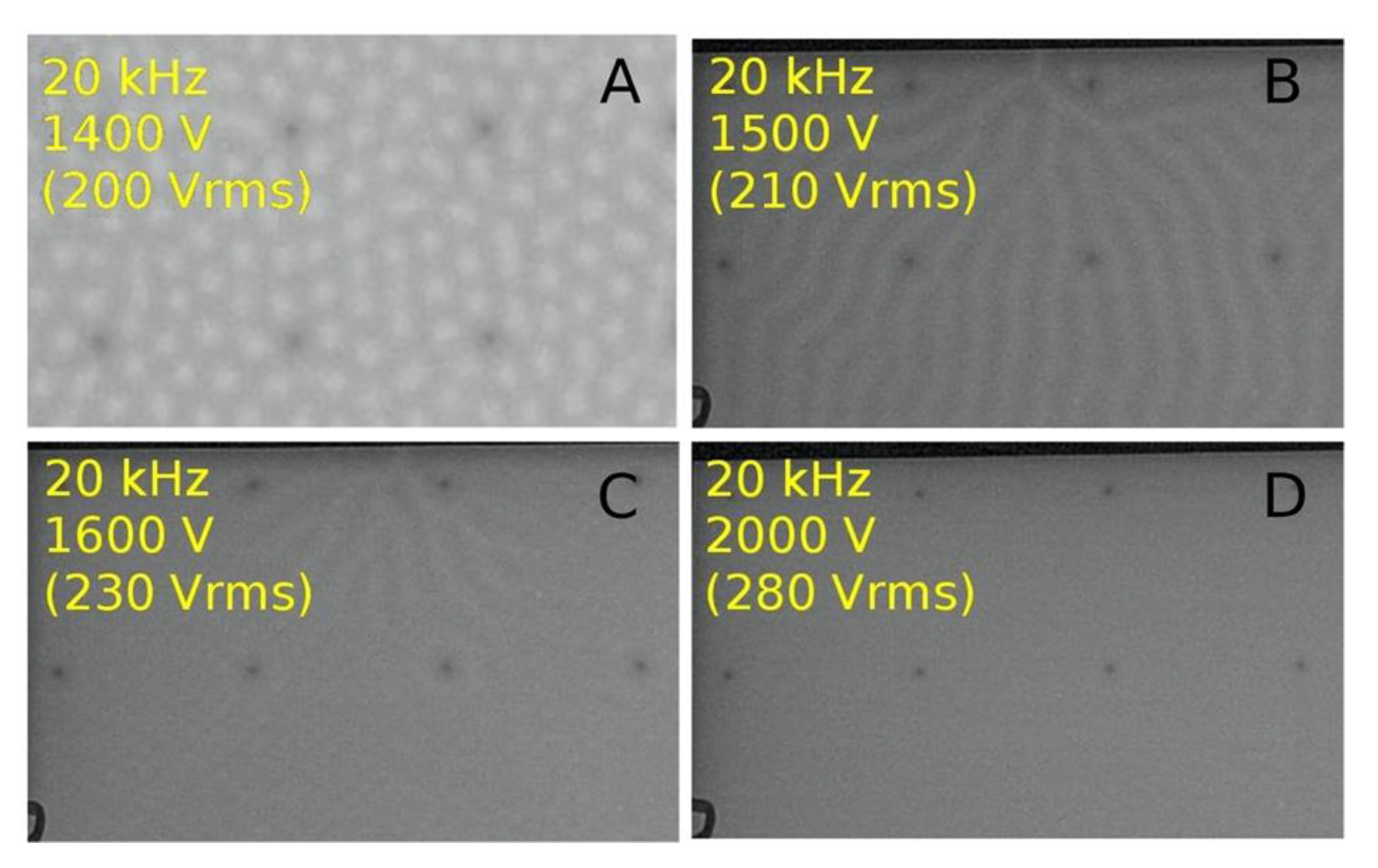
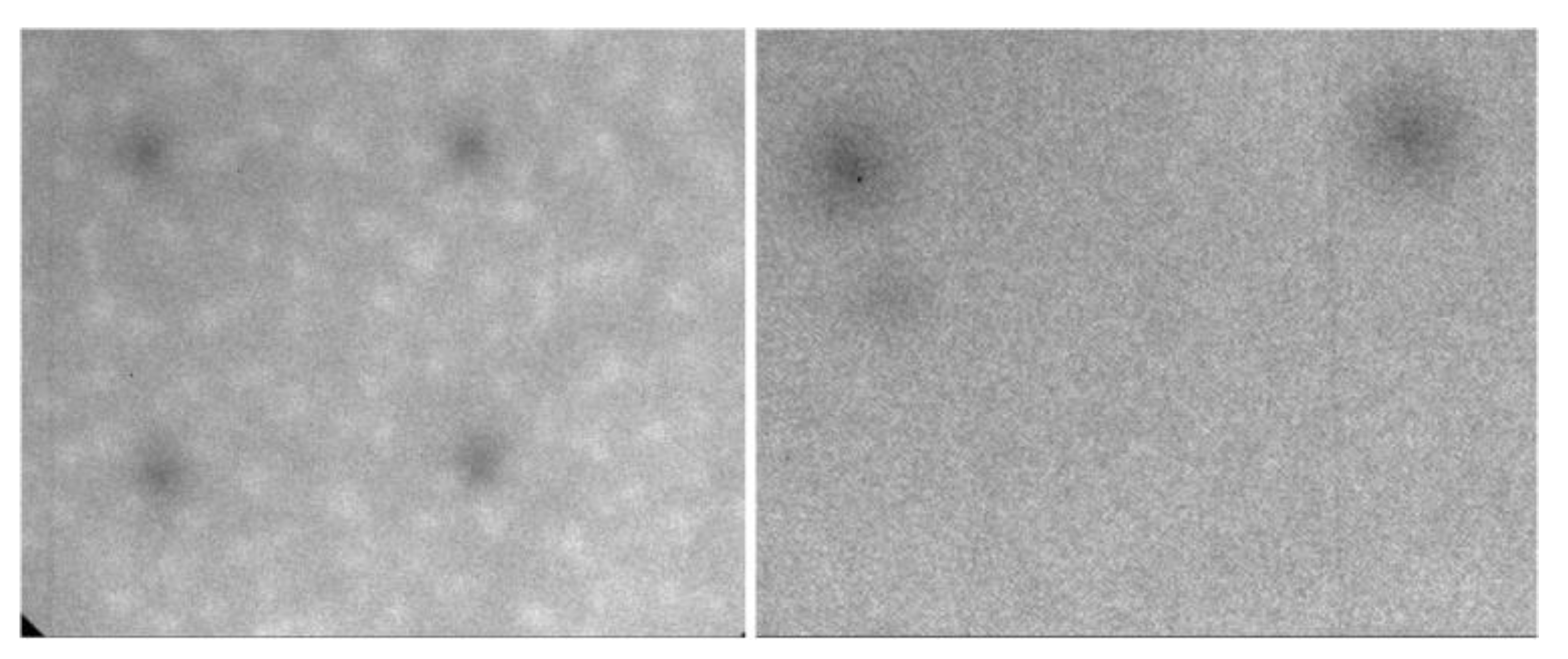
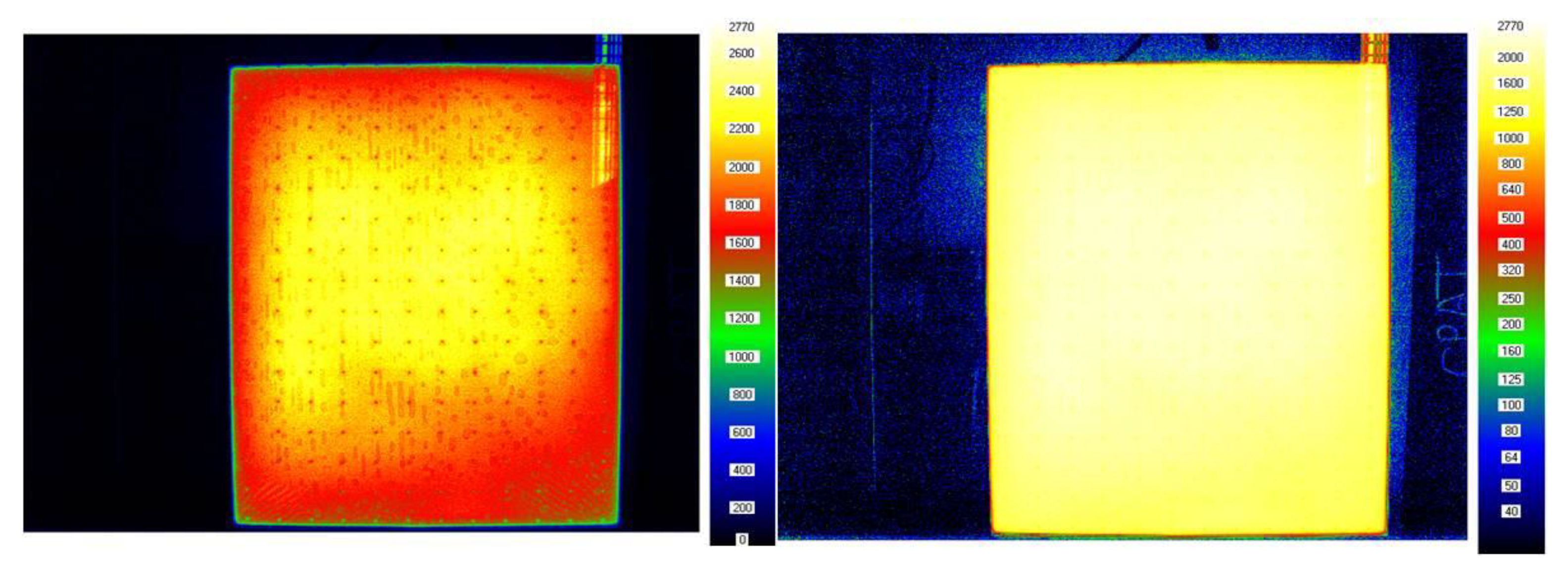
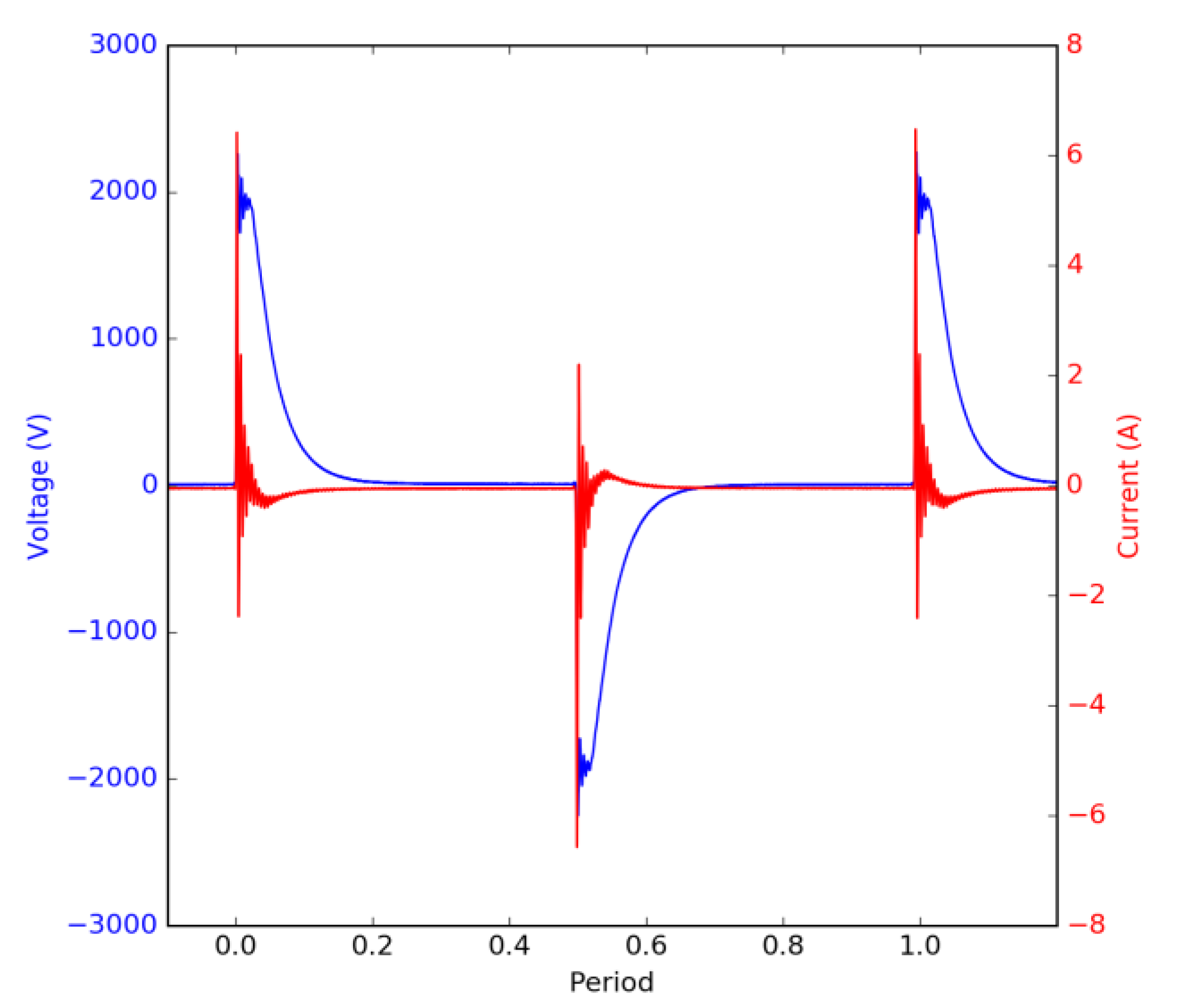
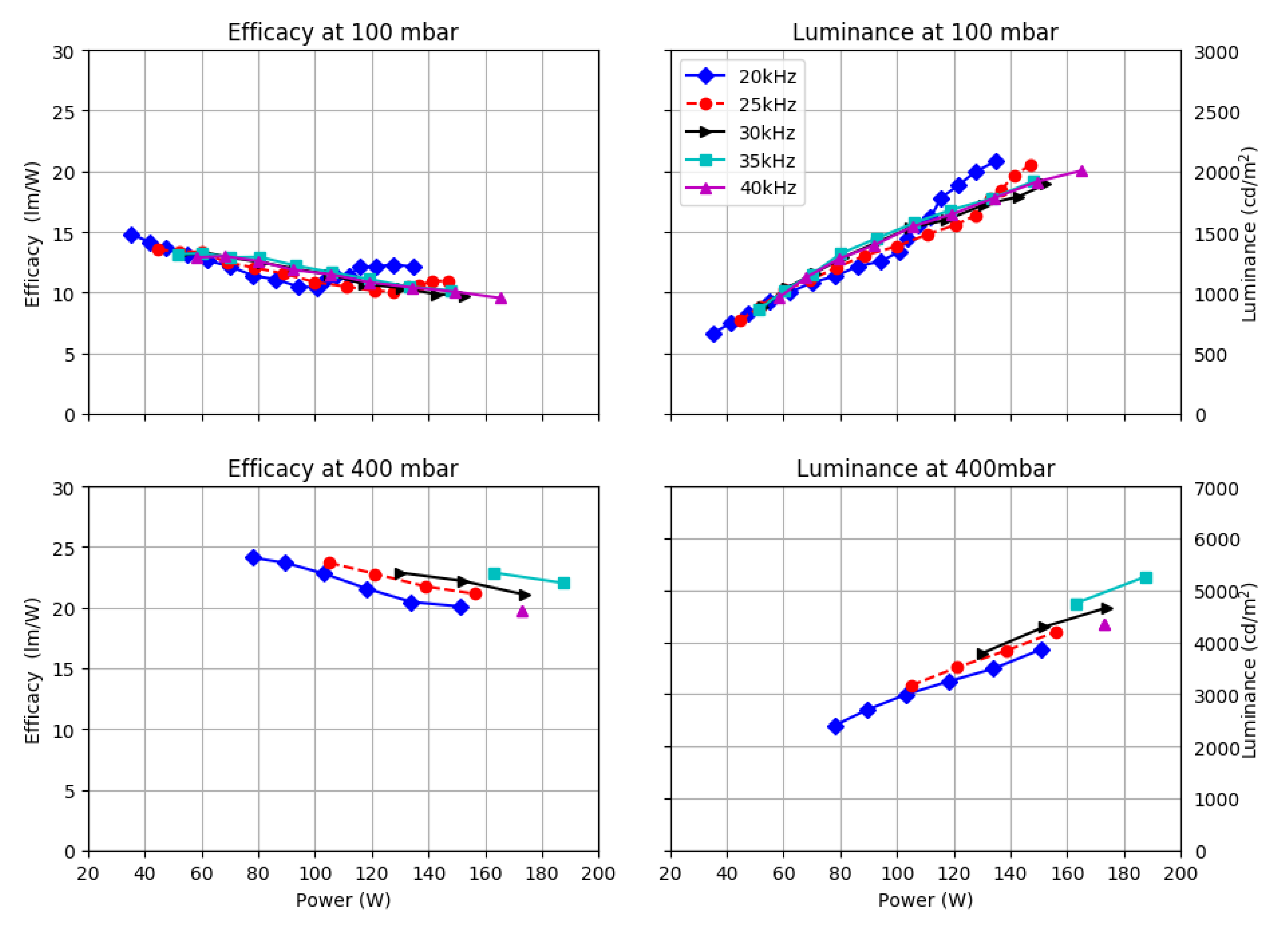




| Pressure Ne–Xe 50% | Mean Efficacy (lm/W) | ||
|---|---|---|---|
| Plane-to-Plane | Complementary Configuration | ||
| (mbar) | Pulse | Sinus | Pulse |
| 100 | 12 | 14 | 29 |
| 150 | 14 | 15 | 30 |
| 200 | 15 | 15 | 28 |
| 250 | 17 | 16 | 30 |
| 300 | 19 | 30 | |
| 400 | 22 | 31 | |
Publisher’s Note: MDPI stays neutral with regard to jurisdictional claims in published maps and institutional affiliations. |
© 2021 by the authors. Licensee MDPI, Basel, Switzerland. This article is an open access article distributed under the terms and conditions of the Creative Commons Attribution (CC BY) license (http://creativecommons.org/licenses/by/4.0/).
Share and Cite
Caillier, B.; Therese, L.; Belenguer, P.; Guillot, P. Parametric Studies of a Mercury-Free DBD Lamp. Plasma 2021, 4, 82-93. https://doi.org/10.3390/plasma4010006
Caillier B, Therese L, Belenguer P, Guillot P. Parametric Studies of a Mercury-Free DBD Lamp. Plasma. 2021; 4(1):82-93. https://doi.org/10.3390/plasma4010006
Chicago/Turabian StyleCaillier, Bruno, Laurent Therese, Philippe Belenguer, and Philippe Guillot. 2021. "Parametric Studies of a Mercury-Free DBD Lamp" Plasma 4, no. 1: 82-93. https://doi.org/10.3390/plasma4010006
APA StyleCaillier, B., Therese, L., Belenguer, P., & Guillot, P. (2021). Parametric Studies of a Mercury-Free DBD Lamp. Plasma, 4(1), 82-93. https://doi.org/10.3390/plasma4010006






